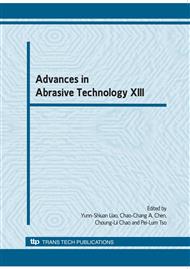p.143
p.148
p.154
p.159
p.165
p.171
p.177
p.181
p.189
A Study on the Spiral Polishing of the Inner Wall of Stainless Bores
Abstract:
This study investigates a spiral polishing mechanism in polishing the inner wall of stainless bore with the mixture grinding material of silicon carbide and polystyrene. The delicate polishing process is verified to be more efficient, cost-saving, and environment friendly than traditional processes. Varied sets of polishing parameters, including SiC grain size, SiC weight, polystyrene(PS) weight, viscosity of silicon oil, revolution speed of the driving screw, and machining time, are examined through the Taguchi Methods for optimum polishing effects. Impacts of different combinations of the six polishing parameters on surface roughness and texture are probed into and analyzed in the process of the experiment. The findings suggest that with the increase of time, the fluidity and stickiness of the abrasive medium improve, resulting in a finer polished surface within delicate spiral polishing process. It appears that significant differences are observed through the use of a mixture of 60 grams of SiC (with size of 7 μm) and 70 grams of polystyrene, silicon oil of 1000 mm2/s viscosity under the speed of 3500 rpm screw revolution speed for 30-minute machining time, improving the surface roughness from 0.90 μm to 0.158 μm Ra. The finding thus lends support to the effect of spiral polishing mechanism, which can be further developed.
Info:
Periodical:
Pages:
165-170
Citation:
Online since:
August 2010
Authors:
Keywords:
Price:
Сopyright:
© 2010 Trans Tech Publications Ltd. All Rights Reserved
Share:
Citation:


